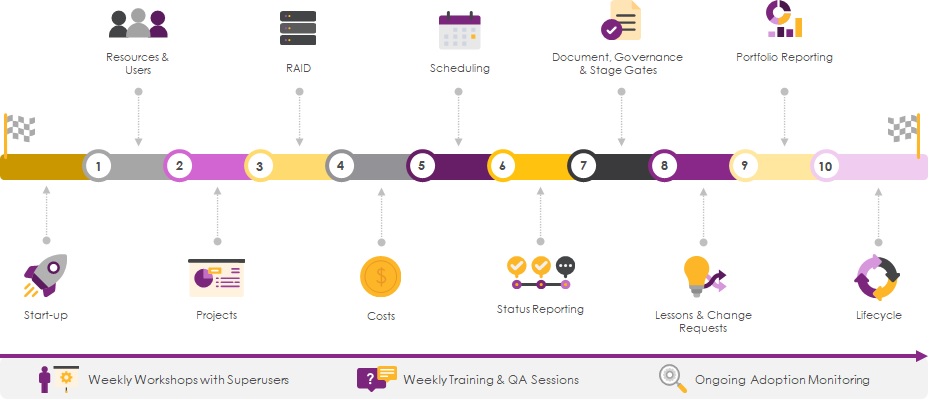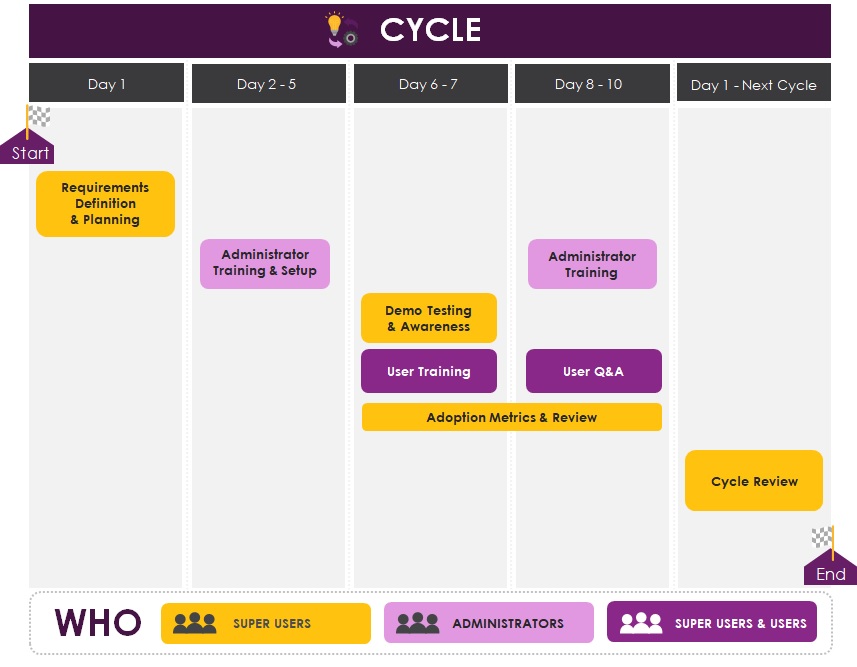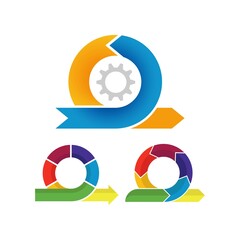Up until 2019, PPO approached project portfolio management (PPM) software implementations in a typically waterfall approach. We would spend full days with our clients meticulously taking down requirements and then carefully crafting the best solution to meet those requirements – and it worked well – so why did we change our ways? Well, let’s think of the typical issues PPM software implementations face using a waterfall approach.
- Requirements have to be very clear from the outset which is often not realistic as the client doesn’t know what they don’t know.
- When changes need to be made, it can be very tricky to roll back to a previous stage or phase.
- Because user testing and training starts after all configuration and set-up is complete, there is a good chance that we find that the requirements given by the client project team, owner or sponsor are not quite in line with how the Project Managers and other users actually work.
- The end result might not match the clients need by the end of the PPM software implementation project as requirements may have evolved or changed in that period that configuration and set-up took place.
- The users only get to use PPO after at the end of the project thereby missing out on the value PPO provides.
- User training is done in one or two long sessions which means that the users are expected to learn how to adopt a large spectrum of functionality in a concentrated amount of time.
- Data loading can be overwhelming for users especially Project Managers who would then need to get all their project information, RAID (Risks, Actions, Issues and Decisions) logs, costs, benefits, documents into PPO meaning time away from actually managing their projects.
- Between the requirements not meeting their actual needs, intensive training and data loading, Project Managers may end up frustrated and negative when it comes to PPO and this directly impacts adoption of the PPM software.
- A stabilisation phase was needed to monitor, support and tweak once execution was completed.
Once we moved to an iterative approach, we noticed the following advantages:
- Client project teams were continually involved with the configuration and set-up of PPO meaning that tweaks, changes and decisions could be made quickly and easily without affecting overall delivery. It also meant that the client and their project team seemed to have more of a sense of ownership
- By interacting with users every week during the PPM software implementation, frequent feedback helped shaped the functionality to support how users actually worked. We noticed that the users, like the project team felt part of the process of implementing the PPM software.
- Weekly user interaction also meant short, directed training with manageable data loading in each iteration. It also meant on-going support and stabilisation for functionality in previous iterations meaning a full stabilisation project phase was no longer needed.
- Flexibility of deliverables meant that iterations could be rearranged and re-prioritised so that users were getting the most value out of the PPM software as requirements evolved.
- Value was present from the end of the first iteration as users could immediately start using PPO’s PPM software.
So how does PPO’s iterative approach actually work?
Our PPM software implementations are born out of the client’s need for improved project and portfolio management and reporting. The process starts with identifying the capabilities that the client wants to introduce. Examples of such capabilities are:
- The ability to provide a central repository for project registration and visibility of the project portfolio
- The ability to automate and centralise the recording, tracking and reporting of project related items, specifically RAID
- The ability to provide a flexible governance model with automate governance checks.
Once we have determined the capabilities the client wishes to introduce into the environment, we break up the work into iterations or cycles.

In each cycle we will focus on an area in PPO that requires tailoring and configuration to suit the client’s needs. The number of cycles depends on the number of areas in PPO included in the scope of the PPM software project. Cycles are typically 2 weeks, however where functionality or adoption may be more complex, cycles have been extended to 3 weeks.

As we go through the cycles, users are trained and start using the functionality deployed. Each cycle therefore has a set of activities that are spread over 2 weeks.
- Requirements Definition and Planning
This will take the form of a workshop (typically 2-4hrs) with the client project team to define and align on the requirement, current way of work and plan and scope of the data take-on and training approach. This is a key change management activity and ensures buy in from project team as they help define the requirement. It also allows the project office and PPO to understand the current data and way of work, which is key. In this session, the PPO Consultant gets to the bottom of the clients’ needs for that particular area in PPO.
- Administrator Set-up and Training
The PPO Trainer takes the requirements laid out in the requirements session and coaches the PPO Administrators in configuring and setting up PPO to accommodate these requirements. We perform administrator training during this process and do the basic set-up together. This allows the administrator to get familiar with the product and gain the necessary training and experience required to manage the system post the implementation.
- Demo, Testing and Awareness
Once the configuration has be done, the project team convenes and the PPO Consultant takes the team through the functionality that has been set up as per the requirements session. The configuration is then signed-off or tweaks and changes are decided on.
- User Training
Once the project team is happy with the way PPO has been configured for RAID items for example, the general user base is trained on how to add their RAID log to PPO and how to manage it. They would also be given the task of getting their RAID log onto PPO.
- User Q&A
In the second week of the cycle, the users have a chance to bring any questions they have to the PPO trainer in a Q&A session. This is a support session to enable them to ensure that they understand the functionality and can use it effectively.
- Adoption Metrics Review
Throughout the process PPO and the project management office (PMO) will review the real time available data adoption metrics to measure the process of the user’s adoption of the new way of work. The metrics provide insight into where and how much hand holding and coaching will be required.
After users are trained on the functionality, the PPO project team tracks adoption, particularly in the areas being dealt with in that cycle. Metrics like User Logins, Total Hits, Average Hits Per User Group are tracked. We also track Data Completeness and Data Quality. Through this monitoring we can identify gaps in adoption and quickly attend to those issues.

- Cycle Review
Once the users are up and running after training, a review of the cycle is done to determine if all requirements and objectives set out for the cycle have been met. If the project team is happy that this is indeed the case, the next cycle commences.
Who are the client role players?

Pivotal to the iterative approach are the client’s PPO Administrators. These are the individuals who will administer and maintain the PPO instance post implementation. During the PPM software implementation they will work alongside the PPO resources to set-up and configure PPO thereby learning in a hands-on, practical approach.
The super users are a group of users that are made up of PMO Staff (including the PMO Manager / Project Owner) and the PPO Administrators; and selected Project Managers to help define and contribute to the requirements and assist with the testing. They should be actively managing projects and will thus assist to ensure we address and test requirements from the project manager’s point of view.
Users cover all the people that will ultimately be using PPO and will require the necessary training and access.
What have the clients had to say about PPO’s iterative approach?
“A critical part of the success of the PPM tool rollout was the agile approach taken by the organisation when it came to implementation. This more methodical rollout process of the PPM tool definitely made for its major success. The approach has highlighted that the adoption of new tools in this manner is best practice when it comes to ensuring their sustainability.” Aluette Vermaak, Harmony, Transformation Project Management Office
“The change management process over this time has been critical, and all team members have been involved, with decisions being made based on consensus. The fact that the entire team was able to provide input into the customisation of the system definitely made it easier to grasp and take on board.” Shuaib Mohamed, V&A Waterfront, Fit Out Project Management Office.
“PPO as our implementation partner showed immense expertise, was passionate about moving our environment forward and was excited to share their knowledge with our team.” Gillian Stern, PG Group.
“The hands-on approach has always been appreciated, PPO provides a great service; they always tailor to our needs rather than feeling like they are sticking to a script. Meetings feel a lot more personal rather than it feeling like just a business transaction; we have a great rapport with everyone on the team.” Josh Lumley, PMO Analyst at large UK based insurance company
In closing, as a PPO team member working on various projects, I have found it extremely rewarding to see my clients getting immediate value out of the product. The visibility and collaboration ensures that the users of all levels take ownership of their PPO instance. They gradually become more confident with each cycle and start to enjoy the benefits of managing their projects on PPO.
There are many shared learnings along the way for all concerned. As the functionality is rolled out it is satisfying to see the burst of “ah-ha” moments as they see the prize at the end of each iteration. The highlight is at the end of the PPM software implementation when the team realises that they are collaborating more efficiently, running projects more effectively in a standardised way and of course – effortlessly generating reports and dashboards. This prize is not like receiving a gift-bag at the end of a day long training session, it is more like reaching a destination after a wonderful journey of discovery and growth that you know will impact your day-to-day working life within your PMO.
If you’re planning a PPM software implementation or have problems with an existing implementation then I hope this helps. If you’re keen to learn more about our PPM software implementation, get in touch. We’d love to help!


